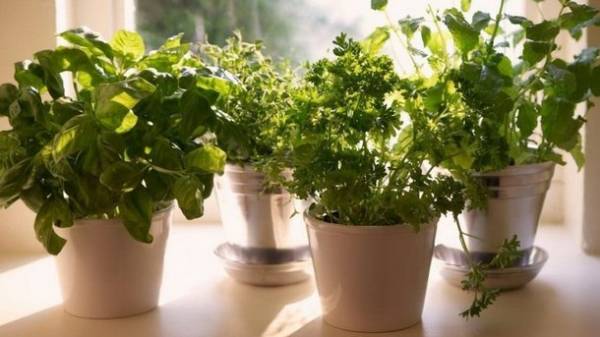
The end of winter and beginning of spring — a time when we are sorely lacking vitamins, overcome colds and pesters the seasonal Blues. The easiest and most reliable way to enrich our diet with fresh greens is to grow to table salads, onions and condiments on their own. In this case, they are guaranteed to be free from nitrates and pesticides, as well as fresher, cheaper and tastier than those bought in the supermarket.
About sowing and the rules of growing fragrant “groves” on the window sill — fashion direction in indoor vegetable production — “Today” said the experienced woman from Zhytomyr Nelly Lupinus and PhD agronomist Dmitry Maydanyuk (Kyiv).
Growing greens on the windowsill requires high light, so you need to choose the South-Eastern or southern windowsill. Besides, it is desirable 3-4 hours to dosvechivat plants — this will increase the yield and accelerate the appearance. The success lies in the proper selection of soil for plants (usually require light, well-drained fertile soils of), varieties for planting (early and early maturing) and adjusted temperatures.
ALFALFA FORAGE
Alfalfa is a valuable forage, the seeds of which can also be purchased in stores seeds can be used to eat as sprouts. To do this, 10-20 g of seeds placed in a jar with a capacity of 0,5—1 l, pour water so that it covered the seeds, and leave for 8-12 hours. Jar is covered in a cotton fabric, securing it on the neck and drained of water through the fabric. The seeds are then again filled with water, changing it daily the same way. The Bank kept at a temperature of 20-25° C in diffuse light. Sprouts can be eaten in 5-7 days, when the twisted mass of white stalks and light green leaves almost completely fill the jar.
Sprouts of alfalfa resemble watercress and green peas.
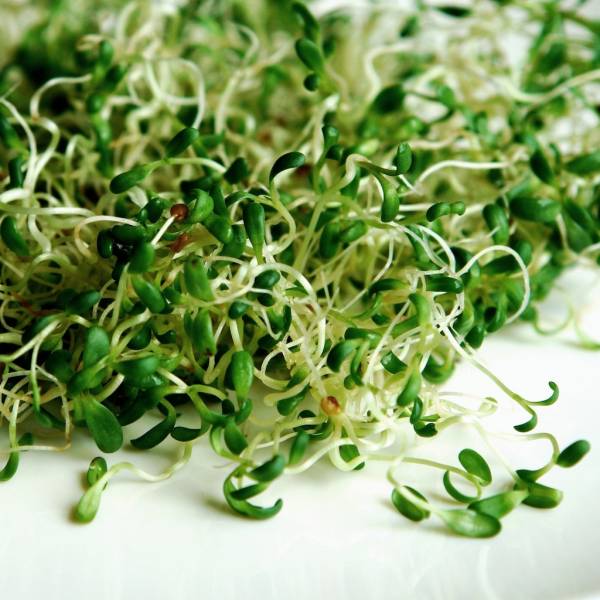
Sprouts. Sheets and taste of green peas is ready in 5-7 days
BORAGE, AKA BORAGE
Borago, or borage, is a nice cucumber scent that apply when cutting off the leaves of this plant. His second name — borage officinalis, and for good reason: it has a light urine and diaphoretic action. In the spring this plant can be used as a substitute for cucumbers, it also gives them specific summer flavor soups, borscht and salads. And edible flowers are a wonderful decoration of any dishes.
Borage seeds germinate quickly and have high viability. It feels good in partial shade, so is perfect for growing in the winter on the windowsill. We need only time to thin out, as borage forms a powerful outlet. Best fails of Borago at temperatures of 13-18° C and infrequent watering. This plant is responsive to feeding, sharply accelerating the growth when entering with irrigation water nitrogen and phosphorus water soluble fertilizer (1-2 g per liter). You should also be aware that if you want to not only grass, and pale purple flowers, and plants, it is necessary to create good conditions. But remember: the leaves stiffen, losing edibility.
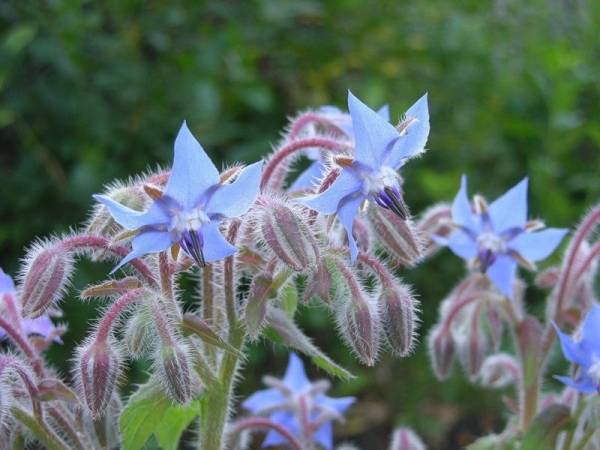
The borage. When there are purple flowers, leaves stiffen
WATERCRESS
This is one of the earliest maturing plants. Already after 14-18 days, when they reach a height of 5-7 cm, notched leaves with a characteristic odor, pleasant bitter taste, can be cut. They significantly improve the taste of soups, salads, meat and fish dishes. Moreover, vitamin C in this plant — 120 mg per 100 g of green weight. Also it has a lot of carotene, potassium, iron, iodine, it is useful in anemia and hypovitaminosis.
To grow cress in a very thin soil layer (2-4 cm), and even on a layer of damp cotton wool or filter paper. Scatter seeds on the soil surface, sprinkle a thin layer of fertile soils and moisture from a spray. Because watercress seeds germinate in 2-4 day, a container of seeds immediately exposed to light. Watercress tolerates some shade, but for the uniform growth of “bed” need to turn. As with the running of the heating in the apartments is very low humidity that this plant does not tolerate, it should be regularly sprayed from a spray. The ideal temperature for its cultivation is 10-15° C, so that you can easily grow watercress even in a cool room such as a glazed balcony. Conversely, at high temperatures of soil and air leaves quickly stiffen and grow old, and the plants “shoot” and begins to taste bitter. For the organization of the green conveyor is to organize the sowing of seeds of cress every 1-2 weeks.
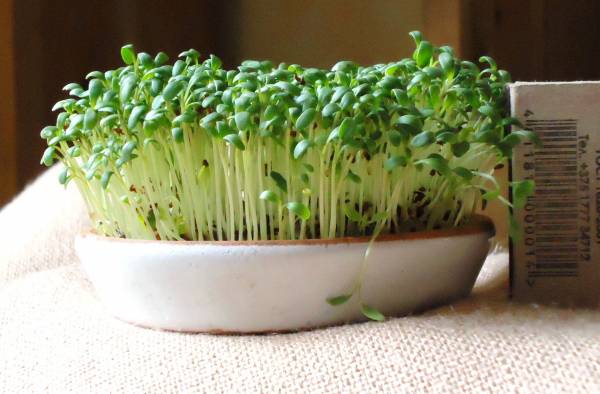
Skorospelka. Already after 14-18 days you can cut the leaves
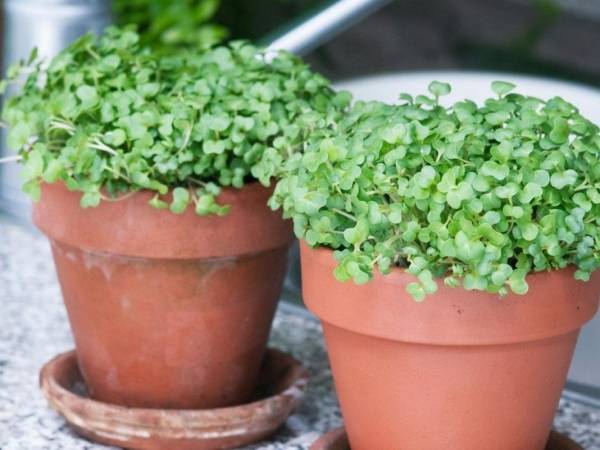
To the sun. For uniform growth of “bed” need to turn
THE BEAN SPROUTS
Before sowing the bean seeds are soaked in cold water until they swell slightly. After that, prepare the capacity of small depth, the bottom of which is lined with porous water absorbent material — foam, wool, coconut fiber. You can use a folded in several layers of cotton fabric. Good wetting material, evenly laid seeds all over its surface. Capacity covered with glass or plastic wrap to maintain high humidity, but you need to leave holes for ventilation. Container put in a warm place and covered with a dark cloth to exclude light. You need to constantly maintain in the high humidity. The optimum temperature for bean sprouts — 18-24° C. the warmer it is, the faster you can harvest. Sprouts become fit for use on a 4-9 day, this time white fleshy seedlings reach a height of 4-5 cm, you should Not allow them to grow.
Do not give beans to grow: seedlings suitable for 4-9 day
TIME DILL — THE KING OF SPICES
This plant is called the king of our spicy. Its full Latin title is translated as “dill” or “selenophori”. But to get the greenery in the indoor environment need a lot of effort — it does not tolerate shading, as it loses its flavor. Therefore, the place of growing dill should be ventilated and well lighted. It is also desirable to arrange for supplementary lighting. If you have plantings placed on a light window sill, install fluorescent lights at a height of 50 cm above the plants (in the spring is sufficient to turn them on in the morning for 3-4 hours). And if the boxes with dill standing in the back of the room, the supplementary lighting should last at least 15 hours.
The soil should be light, nutritious, well-drained. Best buy in store of fertile soils for seedlings. Because of the high content of essential oils of dill seeds long enough to sprout, they need before sowing soak for 20 hours in warm water, through which to try to artificially saturate the water with oxygen — for example, by a compressor from the tank. Another option is to place the seeds in warm water for two days, every six hours, changing it for fresh. As well as other crops with small seeds, sowing of dill is carried out in the small grooves located at intervals of 4 cm, slightly Petrushevych seeds with soil. The soil is watered from a spray bottle. As soon as shoots appear, move the boxes into the light. Pour the fennel often, but little by little, avoiding waterlogging. For sowing in the room you should select shade-tolerant, early Bush varieties that can be cut repeatedly. The first harvest of greens you can gather in 25 to 30 days, and every three weeks to deceiving.
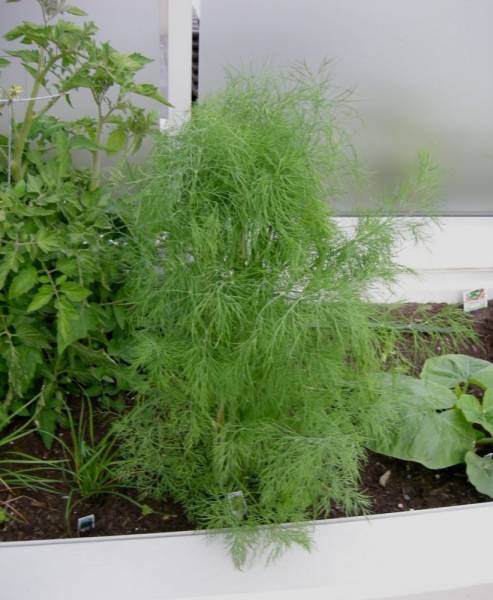
Harvest. 25-30 days
LEAF MUSTARD
This is a great seasoning and a source of greens which can be obtained in winter on the windowsill. Curly, pale, bluish-purple veined leaves are thin, slightly bitter taste and a pleasant mustard flavor.
Mustard, a close relative of cress, also differs amazing maturity and ruggedness that allows you to grow it on the windowsill. The seedlings reach a height of 5-7 cm, finding suitability for use in 10-12 days. Mustard grows well on filter paper or in a thin layer of soil, but its yield increases when you sow seeds into the soil layer thickness of 5-10 cm is Ideal for her, the temperature of 10-15° C and high humidity, so you can carry out its joint planting with watercress salad in the same container, growing salad mix.
Similarly, the mustard can be grown turnip seedlings which have a more intense green color. For growing on the greens it is better to choose varieties of turnip with glabrous leaves Tokyo-market, Geisha, Eye.
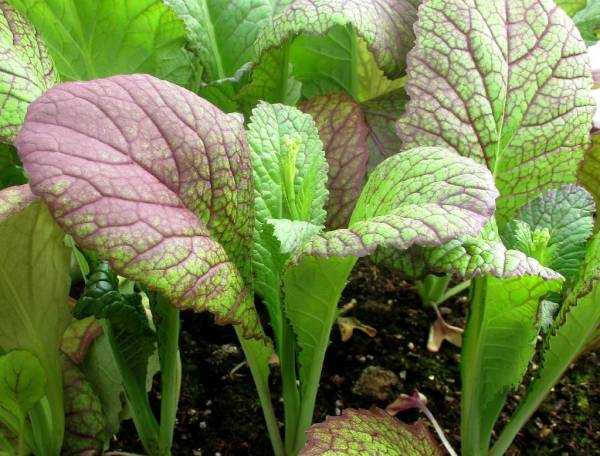
A relative of watercress. The seasoning and the source of spring greens

Quickly. After 10-12 days, leaf mustard will delight the gourmet
VERSHKI I KORESHKI
Radishes are also quite suitable for growing on the windowsill. But to get full root difficult: need bright light, but daylight should be short, no more than 8-10 h. Then the radish does not throw the arrow, starting to bloom, and forms a dense, tender and juicy root vegetable. The second condition — cool: temperature in growing areas should not exceed 20° C, and most favorable 12-15° C. the Scheme of planting of radishes is 5×5 cm With more dense growing roots are not formed, and the shortage of irrigation. The depth of the layer of soil should be 15-20 cm the Soil should be light, sandy, rich in nutrients, especially phosphorus. At the same time, excess humus causes severe leaf growth at the expense of roots. Suitable for a room of ultra-early variety with round roots of Sora, Dabel, Sachs, dawn. But even if the root failed, the tender leaves of the radish are great for salads.
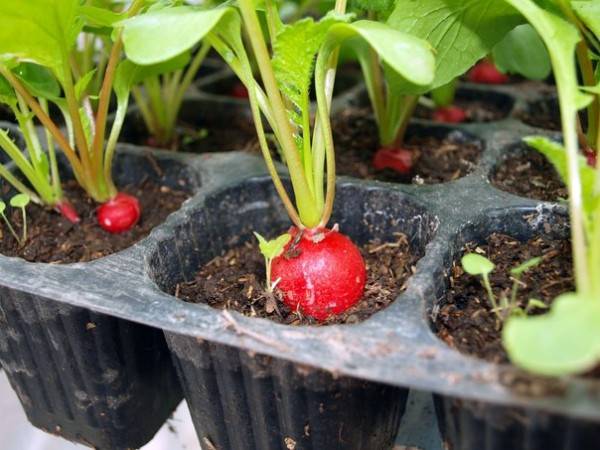
Radishes with tender leaves







